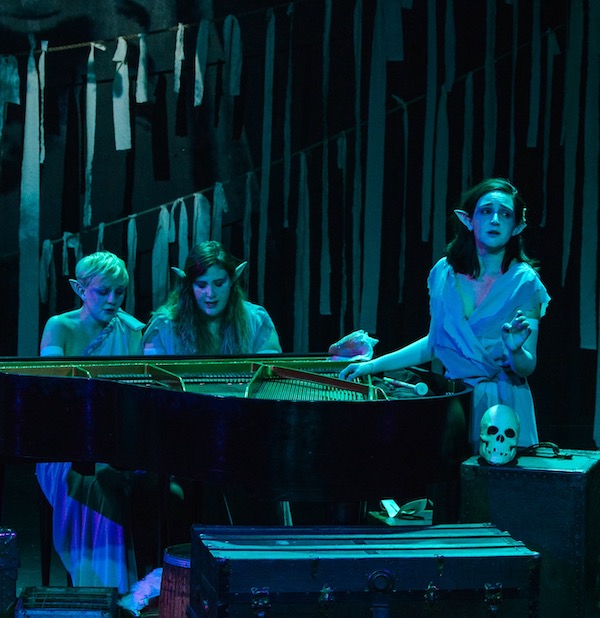Waiting for Odysseus: “Sirens” crowns IN Series’ Women Composers Festival

A Women Composers Festival, presented this weekend by the IN Series, honors the aims of Women’s History Month with distinction. For the marquee event the company has staged Kate Soper’s Here Be Sirens, composed in 2014. Heard on Saturday night at Gala Hispanic Theatre, this virtuosic opera for three sopranos is a work of astounding originality, featuring the three sirens of Greek mythology waiting for the fatal arrival of Odysseus.
Soper wrote her own libretto, a dizzying mixture of classical Greek sources and erudite commentary in English. One of the sirens, Polyxo, has begun to have doubts about why they seduce sailors to their doom. She surveys the history of their origins, as the handmaids searching for Persphone, and their disastrous loss to the Muses in a singing contest, which left them wingless. Implacably, the approaching ship of Odysseus heralds their doom.
The casting was optimal for this tour de force, with three women of different vocal strengths balanced in an ideal ensemble. The most substantial voice, the dramatic soprano of Julie Bosworth, anchored the texture as Phaino. When Soper overlapped the three parts in contrapuntal braids, Bosworth often came last, with the richest, most buttery tone. This worked well with the story, as the third siren is the least conflicted about the nature of their existence.
In the middle as Polyxo was the more silvery-toned Noelle McMurtry, who turned aside from the trio’s singing to ask questions. She went with increasing insistence to a pile of books, quoting Jung, Ovid, Pausanias, and other sources, her thoughtful analysis offering some comic relief from the unrelenting fierceness of the siren song.
The least thoughtful siren was the ditzy Peitho of Camille Crossot, displaying an airy light soprano on the top part, sometimes trending slightly sharp but generally transparent and limpid in the heights. Director Brian J. Shaw centered the action around the grand piano, with its lid removed, like a ritual object around which the sirens gathered. The only accompaniment in the score is this piano, played with extended techniques by the singers themselves. They also worked seamlessly together with no need for a conductor.
Several times throughout the opera, in response to sounds indicating the approach of a ship, the three singers let out a monstrous, animal hiss. Circling around the piano, they intoned a sort of mantra, howling and ululating in a barbaric cantillation. With a mallet and wire brush they drew forth waves of sound from the strings, concluding on a high-set fortissimo chord that set the undampered strings of the piano resonating sympathetically.
The most mesmerizing instrumental sound came near the end of the opera, as the singers wove wires around the piano strings. Giving the impression of the women weaving together on a loom, the sonic effect was a buzzing drone.
The most striking sounds, however, were purely vocal. None more so than the end of the unaccompanied piece “O Sailor,” where the three voices struck dazzling dissonances on high notes, held for a long time. The scintillating overtone vibrations of this half-minute of sound seemed to rewire the listener’s brain. This otherworldly aspect went well with the pointed ears and gauzy costumes designed by Donna Breslin.
Shaw’s production featured a video of crashing surf projected on the theater’s back wall (scenic and projection design by Jonathan Dahm Robertson). Clotheslines suspending strips of white cloth partially covered the back wall, set jangling under flashing light when the sirens wailed their repeated ritual song (lighting by Marianne Meadows). The blackboard opposite the piano featured a partially completed illustration like a female version of Leonardo’s Vitruvian Man.
An hour and a half of music and spoken dialogue, without intermission, the opera was an intense ride. It paired nicely with the opera presented earlier that afternoon in the festival, the charming Ana y su sombra by Gabriela Ortiz. Both are works worthy of attention from many more opera companies.
Here Be Sirens will be repeated 7 p.m. Sunday. inseries.org/women-composers-festival


